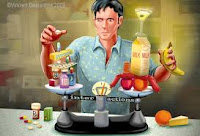Update on drug interactions and foods
Interaction: What do we talk about?
The drug action toward organization may vary, depending on age, medical conditions, weight etc.. but also certain nutrients in foods. Neglected, the risk of interactions between food and drugs are however many, hence the recent development of the Agency for the Safety of Health Products.
We're talking about interaction drug / food when food has a negative effect on a drug, both can then react chemically or compete toward receptor drugs.
What is at stake interactions food / drugs?
If, in the majority of cases, interactions food / drugs have no significant effect, however, some foods have an impact on drug efficacy theoretically decreasing or increasing their toxicity. Most, however, does not change the therapeutic effects.
In practice, the eating habits, standardized and balanced, does not make them incurring significant risk.
What are the mechanisms of these interactions?
Interaction mechanisms foods / drugs are involved variables. Most often, it is known pharmacokinetic interaction, ie implying a change in blood levels. It is especially in cases where changes in concentrations that exceed 30% of the possible consequences.
For example, the formation of insoluble complexes drug / food is responsible for a decrease in the absorption of drugs and / or nutrients.
The nature of the diet (rich or poor fat) can also influence the absorption, i.e. the passage into the bloodstream. Changes in blood concentrations can also be explained by interactions:
- At the level of enzymes responsible for drug metabolism (cytochrome P450 hepatic and intestinal)
- Or carriers for drugs and / or nutrients into the cells or leaving.
Other interactions may also occur - known pharmacodynamic - at the cellular receptors pharmacological response.
Featured: liver, intestine and P450 ...
The amount of drug present in the circulation depends on the amount absorbed by the digestive epithelium but also the process of elimination. The drug is degraded in the intestine, metabolized in the intestinal cells (enterocytes) and liver and disseminated in these two organs. Before being distributed throughout the body.
Metabolism refers to the conversion of the drug in one or more compounds by an enzymatic reaction. Sites of metabolism are the liver and the intestine, and the key elements of this system are the cytochrome P450 enzyme with multiple subfamilies called isoenzymes. Hence the importance of food that act on cytochromes P450, either by activating or inhibiting them.
There are differences between individuals, because of the variety (polymorphism) genetic P450 isoenzymes (or isoforms).
The intensity of interactions can - theoretically - vary from one individual to another.
Alerts: If you want to know more fresh update helpful articles enter your email address below and be notified by mail.









